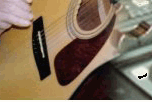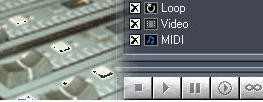





 |
 |
 |
||||||||||
|
|
 |
 |
 |
|
|
|
|
|||||
|
|
|
|
||||||||||
|
|
|
|
||||||||||
|
|
|
|||||||||||
|
|
||||||||||||
APRS
NEWS: STUDIO SECURITY
- DRAFT GUIDELINES - 2004
Version
4: 4-May-2004
There are concerns within the recording industry regarding the security of recordings during the production process. The APRS suggests studios could consider their security by reference to the guidelines, in the form of the checklist below, as a response to those concerns. A studio using this checklist to conduct an audit of their security arrangements can assess how well it ranks by allocating values between 0 and 3
in each section below. Recording studios need to be able to show that they have taken reasonable steps to protect the security of copyright works from unauthorised copying, and to protect finished or unfinished physical recordings - whether made at the studios or brought in for further work - also from loss, damage or theft. However, even a maximum score cannot guarantee the studio freedom from claims. Clients may in any case request other security measures to be adopted. The APRS hopes that studios will find this checklist useful and that insurers will recognise that a high score along these lines would assist studios in negotiating premiums for cover against these risks. |
||
| Pre-Release Security - Preliminary Checklist | SCORE |
|
| Security Policy | All commercially trading recording studios should have a security policy. The terms of a studio’s security policy should be acknowledged in the contract between the client and the studio. | |
| Physical Security | ||
| Access Doors | Unlocked, exterior main doors to studio reception areas should be attended at all times during “working” hours by an experienced responsible person. Studio Access doors should be lockable from the inside. Dark access points should be well lit - possibly by infra-red sensitive floodlights. Recordable CCTV is recommended for secluded entrances. | |
| Deliveries | Systems should be in place which specify where goods, materials and hire equipment are to be revceived that include provision for retention of signed delivery notes. | |
| Collections | Records should be kept of all collections of materials (such as tapes, CDs and DVDs,) made from studio premises includng item, date, time and signature. | |
| Recording Rooms & Control Rooms | Access should be restricted to authorised studio personnel and named individuals listed by client. Ideally, studios and control rooms should be locked whenever the session team leaves them empty or if they are vacant or not in use. | |
| Client materials | Materials - working multi-tracks, hard drives CD ROMs etc - should not be left in control rooms overnight by should be secured in a lockable safe place. | |
| Tapes / Hard Disks Log | Systems should be in place to provide for all materials to be logged in and out of studio buildings so that there is a verifiable "audit trail" for media movements. | |
| Data Security | ||
| Web & email access | Studio internet connections must be fire-walled. Client email/internet access ports should be regularly vetted for rogue software. Notices warning of the illegality of copyright infringement should be displayed prominently. Any computer that connects to the Internet either directly or via a shared network must have an up to date virus scanner. Staff should be reminded that production software is also subject to copyright protection. | |
| Secure File Transfer | Digital file movements should always be via secure transfer network service providers or closed secure infranet systems. The APRS can provide information on recommended suppliers. | |
| Hired-in DAWs | Hired DAWs should be checked for previous session data and anything found should be deleted. Internal hard disk data should be erased before collection by hire companies. | |
| Computers | No desktop or laptop computer should have any P2P sharing programs installed (KaZaa, Bearshare etc). Notices forbidding client use of portable download devices (laptops, PDAs, mobile 'phones etc.) should be prominently displayed. | |
| Wi-fi | If there is access to a wireless network connection, the connection should have been set up to use access control lists and WEP encryption. | |
| Blank Media | Any media created during a session should be identifiable and logged into a tape/disk logging system. This can be a simple paper based system or a software database solution. Consideration should be given to watermarking all blank media (EXCEPT MASTER MEDIA*) to provide an evidential audit trail and a promotable deterrent againgst careless copying. New blank media coming into the studio from outside should be logged, marked with an indelible marker and, if possible, watermarked at the point of burning, as should any media leaving the studio. * Watermarking is not recommended for any media that is used for the fixation of master recordings as interference with the purity of the audio signal may compromise the fidelity of the recording. |
|
| Transportation | ||
| Couriers | The studio should use an approved courier or carriage company for all media deliveries. Courier companies should be fully appraised of the security issues surrounding media transfers and their responsibilities confirmed in a legally binding agreement. Individual couriers, drivers and riders should carry photo ID. | |
| Media Transfers | All media should be logged at the point of leaving the studio so that responsibility for its security and integrity until its acceptance at its destination lies clearly with the carrying company by virtue of the signature of an identified employee of that company. | |
| Media Transfer Logs | Verifiable details of the identity of the courier and those of the person designated to receive the media at its destination should be recorded in a delivery note, a copy of which is retained by both the consignee and the recipient.at the receiving end. | |
| Media Packaging | Media should be sealed with anti tamper labels to prevent unauthorised copying while in transit. | |
| Media Integrity | All media, including work in progress, when transported by a cab or courier, should be appropriately packaged,preferably boxed and labelled showing the details of the destination and the name of the recipient. The APRS recommends the use of couriers that offer security transportation services wherever possible but acknowledges that such services may not be available in some geographical areas. An experienced member of studio staff should supervise the loading of the media into the vehicle ensuring that there are no magnetic sources in the vehicle within the proximity of the media being transferred that could damage the material. ( eg: sub-woofers in the boot) | |
| Personnel | ||
| Terms of Employment | Studios should retain employees under a contract of employment that includes an undertaking by employees to respect the integrity of copyright works including the works of company clients and protected software that may be used as a part of their employment on or off the premises. | |
| Awareness | Studios should undertake to ensure that their employees receive thorough training so that they are fully aware of the need for studio security. | |
| Notices | Studios should consider displaying notices prominently that convey to employees, clients and visitors the value of copyright material and the importance of maintaining a secure studio environment. | |
| Artists and Visitors | Clients must be made aware that the behaviour of artists or visitors introduced to the studio premises by them may jeopardise the security of the recording/session and that any subsequent breach of security is entirely the responsibility of the client. | |
Comments and Scoring Guidlines These guidelines are only for guidance of, and consultation between, APRS members and APRS cannot accept responsibility for liabilities which studios, whether or not APRS members, may have in any aspect of their own businesses. Particular security policies or measures mentioned in these Guidelines are for consultation only and APRS also cannot accept responsibility for the consequences of any particular studio adopting any measure suggested in these Guidelines: studios and those who run them must make their own best business judgment. Although these Guidelines do not comprise an actual or proposed Code of Conduct, APRS members are invited to contact [email protected] or Peter Filleul on 020 8699 1245 with comments. As a rule of thumb, scores between 1-25 should be regarded as disappointing, 26-45 barely adequate, 46 - 66 as optimistic. |
||
Download this checklist as a PDF file
| With free Acrobat Reader�
software, you can view and print Adobe PDF files. |
About the APRS | Contact us| How to join | Our Members | Main
index
News | Post | Legal | Links | Education
& Training | Members
section